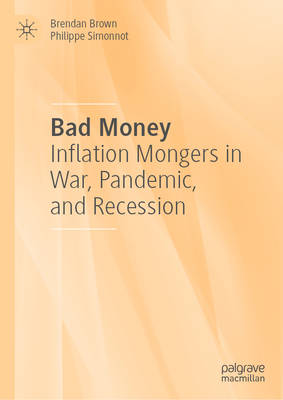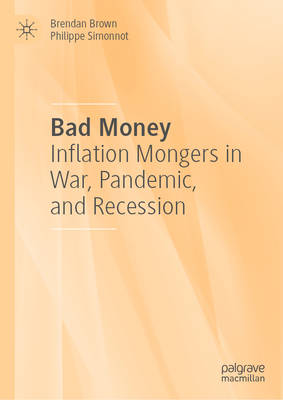
Je cadeautjes zeker op tijd in huis hebben voor de feestdagen? Kom langs in onze winkels en vind het perfecte geschenk!
- Afhalen na 1 uur in een winkel met voorraad
- Gratis thuislevering in België vanaf € 30
- Ruim aanbod met 7 miljoen producten
Je cadeautjes zeker op tijd in huis hebben voor de feestdagen? Kom langs in onze winkels en vind het perfecte geschenk!
- Afhalen na 1 uur in een winkel met voorraad
- Gratis thuislevering in België vanaf € 30
- Ruim aanbod met 7 miljoen producten
Zoeken
Bad Money
Inflation Mongers in War, Pandemic, and Recession
Brendan Brown, Philippe Simonnot
Hardcover | Engels
€ 152,95
+ 305 punten
Omschrijving
This book argues that the blame for the 'Great Pandemic Inflation' in the US and Europe lies with serious flaws in the actual monetary regime. Money is literally out of control with no solid anchor. In consequence further great inflations lie ahead, whether the proximate cause is another massive supply shock (for example war, trade conflict, resource famine) or fiscal explosion or simply malfunctioning of the corrupted monetary system. The book draws on monetary principles applied in the laboratory of history - including wars, great recessions, and US wave elections - to make its key points. The choice of monetary principles is eclectic, including insights from Austrian School and previous works of the authors. The historical examples stretch from the 1890s to the present day. The authors do not shy away from use of counterfactual analysis, including how the shocks from the pandemic or Russia-Ukraine War would have played out under a sound money regime. Questions posed include how a flawed monetary regime has encountered so little political push-back. The answer includes an identification of the sub-groups in the US or global economy who gain from a flawed monetary regime and their wielding of power to protect the status quo. Crucially the book describes how asset inflation, one of the main symptoms of monetary disorder, has weakened opposition to the regime, though ultimately fanning populism due to decades of malinvestment. This book should have wide appeal to academics in monetary economics, international finance, international relations and history, especially those with a passion for the use of history as laboratory. More generally the book should fascinate a wide range of thinkers close to or in the thick of the global financial markets.
Specificaties
Betrokkenen
- Auteur(s):
- Uitgeverij:
Inhoud
- Aantal bladzijden:
- 211
- Taal:
- Engels
Eigenschappen
- Productcode (EAN):
- 9783031954245
- Verschijningsdatum:
- 18/09/2025
- Uitvoering:
- Hardcover
- Formaat:
- Genaaid
- Afmetingen:
- 150 mm x 196 mm
- Gewicht:
- 408 g

Alleen bij Standaard Boekhandel
+ 305 punten op je klantenkaart van Standaard Boekhandel
Beoordelingen
We publiceren alleen reviews die voldoen aan de voorwaarden voor reviews. Bekijk onze voorwaarden voor reviews.









